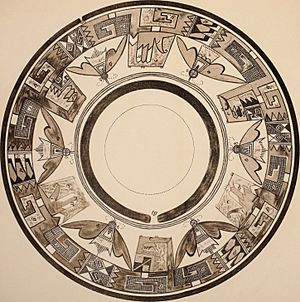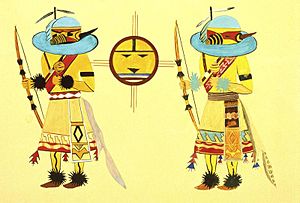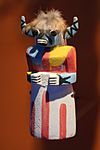Waldo Mootzka facts for kids
Waldo Mootzka (1903–1940) was a talented Hopi artist who used watercolor paints. He was known for his paintings that showed scenes from Hopi life and culture.
Contents
Early Life and Learning
Waldo Mootzka was born in 1903. He grew up in the Hopi tribe near Oraibi, Arizona. This area is also called Third Mesa on the Hopi Reservation. His father was Tom Mootzka, and his mother was part of the Badger Clan. He had three sisters: Daisy, Amelia, and Norma.
Growing up in the Hopi culture greatly influenced his art. He painted many things he saw and learned in his community. When he was older, he went to Oraibi day school. This was a boarding school that tried to make Native American children adopt American culture.
However, some teachers at the school secretly allowed students to paint. This helped students express their own culture. Waldo Mootzka started learning art informally at this school. He also studied in Shungopovi, which is on Second Mesa. Later in his life, he began to learn silversmithing in Santa Fe. Sadly, Waldo Mootzka died in 1940 after a car accident made his tuberculosis worse.
Art Career and Style
Waldo Mootzka's art career began when he watched another Hopi painter, Fred Kabotie, at the boarding school. Mootzka never had a formal art teacher. He taught himself how to paint with watercolors.
Most of his paintings showed Hopi life and special ceremonies. He also liked to try new things with his art more than some other painters. This might be because of new ideas he learned at the boarding school.
Many of his paintings featured Katsinam figures. These are images of special Hopi spiritual beings. He also painted kachina dancers, like those seen in Hopi Kachina figures (Kachina dolls). The Hopi people's beliefs were not much changed by other cultures. This was because they lived in a remote area on three mesa tops in Arizona.
The Studio School Movement

Waldo Mootzka's art was part of a big art trend in the 1930s. This trend was in the Southwest and was called The Studio School movement. Dorothy Dunn, a teacher, started this style. She taught at Santo Domingo Pueblo.
This art style used ideas from European art, like Cubism and Symbolism. But it also kept the "flat style" of painting. This flat style was found in old Pueblo pottery designs and wall paintings. Later in his career, Mootzka spent more time on silversmithing than on watercolor painting. Sometimes, he added Art Deco designs, especially Pueblo Deco styles, to his work.
Where to See His Art
Waldo Mootzka's paintings are in many museums. Here are some of them:
- Brooklyn Museum
- Museum of the American Indian in New York
- Gilcrease Museum Institute and the Philbrook Art Center in Tulsa, Oklahoma
- Museum of Fine Arts, Houston
- Museum of Northern Arizona, Flagstaff, Arizona
- Southwest Museum, Los Angeles, California
- McNay Art Museum



